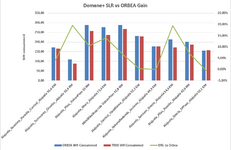AntonioAlfaro
Active Member
- Region
- Other
As I mentioned earlier, my first experience with an ebike was with an Orbea Gain D50 with a rear hub motor, based on the Mahle X35 system with a 250WH battery and a 40NM motor. The total weight of the Orbea is around 13.1 Kg. Rear hub motor ebikes have some particular characteristics that make the riding experience somewhat unnatural. Nevertheless, they are an excellent option, and I have no complaints about it.
Motivated by curiosity to experiment with a mid-drive ebike, I acquired the Domane + SLR 6, which is equipped with a 360WH battery and a 50NM motor. The total weight of the Domane+ is around 13Kg. Based on the data records for each ride I have made on the same route with both ebikes, and trying to maintain the same travel times with both ebikes, I want to show some qualitative results of energy consumption (WH) and efficiency of one system over the other. Please see attached graphs. On average, for that sample of 10 routes (500KM), the Domane+SLR 6 turns out to be 8.14% more energy-efficient compared to the ORBEA Gain D50. This quantitative result is valuable to me from the perspective of future route planning with the Domane+.
In addition to the quantitative data, there is a very different riding experience on the Domane+ compared to the ORBEA Gain, and this experience is a very pleasant and natural feeling when traveling with the Domane+. Although both ebikes have the same levels of assistance programmed, the intrinsic characteristics of each system influence and require a different pedaling style from the cyclist. Let's see why,
Rear Hub System:
1) Independent of cadence
2) Assistance power goes directly to the wheel
3) Independent of gear ratio
4) Linked to cyclist's speed
5) Not suitable for steep inclines.
Mid-Drive System:
1) Linked to cadence
2) Independent of cyclist's speed
Motivated by curiosity to experiment with a mid-drive ebike, I acquired the Domane + SLR 6, which is equipped with a 360WH battery and a 50NM motor. The total weight of the Domane+ is around 13Kg. Based on the data records for each ride I have made on the same route with both ebikes, and trying to maintain the same travel times with both ebikes, I want to show some qualitative results of energy consumption (WH) and efficiency of one system over the other. Please see attached graphs. On average, for that sample of 10 routes (500KM), the Domane+SLR 6 turns out to be 8.14% more energy-efficient compared to the ORBEA Gain D50. This quantitative result is valuable to me from the perspective of future route planning with the Domane+.
In addition to the quantitative data, there is a very different riding experience on the Domane+ compared to the ORBEA Gain, and this experience is a very pleasant and natural feeling when traveling with the Domane+. Although both ebikes have the same levels of assistance programmed, the intrinsic characteristics of each system influence and require a different pedaling style from the cyclist. Let's see why,
Rear Hub System:
1) Independent of cadence
2) Assistance power goes directly to the wheel
3) Independent of gear ratio
4) Linked to cyclist's speed
5) Not suitable for steep inclines.
Mid-Drive System:
1) Linked to cadence
2) Independent of cyclist's speed


